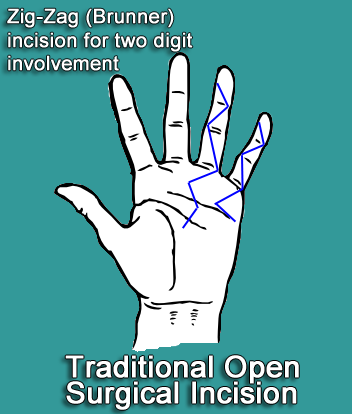Lake Oswego Plastic Surgery®
Tuan A. Nguyen M.D., D.D.S., F.A.C.S.
Board Certified Plastic Surgeon
15820 Quarry Road · Lake Oswego OR 97035
Phone: (503) 635-1955 · Fax: (503) 635-1958
Dupuytren's Contracture
What are other treatment options and risks?
In addition to needle aponeurotomy, several treatments for Dupuytren's disease are available to patients, usually dependent on the surgeon or physician being consulted.
•Traditional Surgery (palmar fasciectomy) - The traditional surgical treatment for Dupuytren's is an open palmar fasciectomy, and involves making a large incision (zig-zag or transverse) on the palm and resecting varying amounts of the palmar fascia.(see below) The overlying skin is sometimes resected as well (dermofasciectomy). A variety of methods have been implemented to heal or close the wound afterwards (primary closure, left open to heal secondarily, skin grafting, local skin flap). This is performed in the operating room under general anesthesia. In addition to standard procedural risks (bleeding, bruising, swelling, damage to nerves/vessels), increased pain and wound healing problems (dehiscence) may occur secondary to a larger incision. Traditional surgery has been associated a with longer and more difficult recovery period. Additionally there are risks with general anesthesia.
The palmar fasciectomy may be the only surgical option in patients with extremely advanced Dupuytren's disease. If during consultation a patient is found to not be a candidate for needle aponeurotomy, Dr. Nguyen is experienced at open palmar fasciectomies and our office would be happy to assist you in scheduling this surgery.
Fig 4. Traditional open palmar fasciectomy to release the ring and little finger with planned "Zig-Zag" (Brunner) incisions marked.
•Radiation - Radiation, a controversial treatment, has been used in the attempt to stop the progression and decrease the symptoms of Dupuytren's disease. Side effects may include skin discoloration, dry and flaking skin, and thinning of the skin. There also may be a very small risk of increasing one's risk of developing cancer after receiving radiation, although the scientific literature on this is not definitive.
•Collagenase Clostridium Histolyticum (generic name) - This is a relatively newer drug that is meant for injection into the cords/bands of scar tissue of the affected digits. The collagenase interacts with the scar tissue (fibrous collagen) and attempts to break it down. If unsuccessful, the injection can only be repeated up to three times. Standard potential side effects include bleeding, bruising, swelling, pain, and damage to nerves/vessels. Additionally, as the collagenase degrades and destroys collagen (which is a normal and abundant tissue in the human body), there is an even more serious risk of damage to surrounding structures (such as nerves and blood vessels) if they come into contact with the collagenase. If a nerve were to be cut in any type of hand surgery, the damaged but cleanly cut ends of the nerve or vessel can be sutured back together and repaired. If there is damage to a nerve or vessel in addition to collagenase, the collagenase continues to degrade both ends of the damaged nerve or vessel, making a successful repair unlikely and resulting in permanent damage. Cost of the drug can also be an issue, especially if treatment needs to be repeated.
•Medical Therapy - A variety of medications have been attempted and used in the treatment of Dupuytren's disease. Unfortunately, there is a lack of scientific evidence showing these medications to work.
•Alternative Therapies - Alternative therapies do not have scientific evidence proving their efficacy. Additionally, most have not been examined and approved by the Food and Drug Administration (FDA) and may have unknown and potentially worse side effects.
![]() Continue to "Why Choose Needle Aponeurotomy?"
Continue to "Why Choose Needle Aponeurotomy?"
![]() Return to "Needle Aponeurotomy Procedure"
Return to "Needle Aponeurotomy Procedure"
To learn more about Dupuytren's disease and treatment options, Please Call or Email To Schedule A Consultation
Call Us
Email Us
tuananguyenmd@gmail.com
![]()
Click to Email
Lake Oswego Plastic Surgery
Please see the provided Additional Links and Resources about Dupuytren's Disease for additional information and references.

